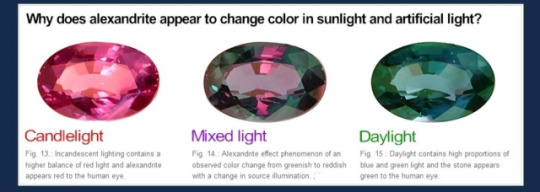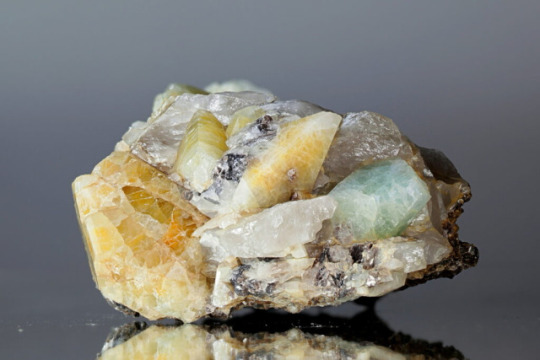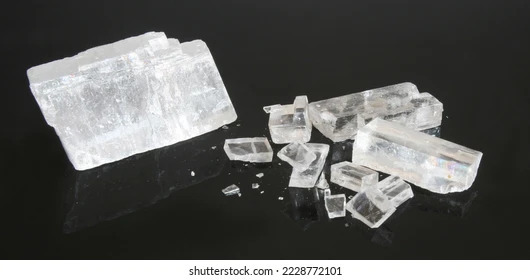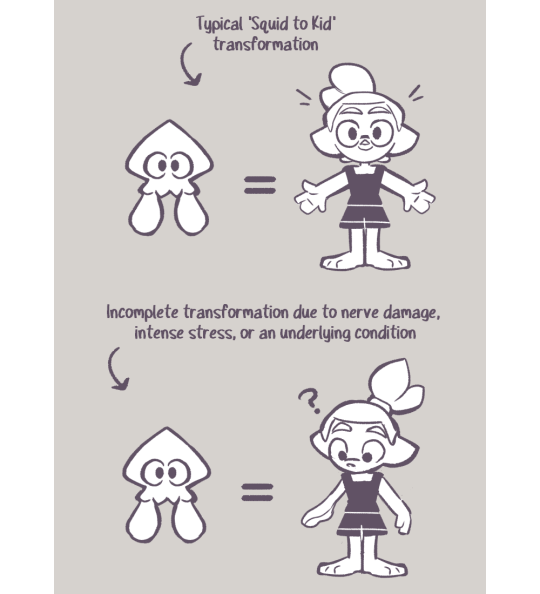#chromophores
Text
#suntan#ultraviolet radiation#UV radiation#melanogenesis#melanin#chromophores#photochemical effects#photobiological effects#DNA damage#oxidative stress#inflammation#health implications#sunburn#premature aging#eye damage#skin cancer#responsible sun exposure#sun protection#broad-spectrum sunscreen#shade#protective clothing#regular skin examinations#risks#vulnerabilities
0 notes
Text
Unlike phytochrome, cryptochrome, and phototropin, UVR8 lacks a prosthetic chromophore.
"Plant Physiology and Development" int'l 6e - Taiz, L., Zeiger, E., Møller, I.M., Murphy, A.
#book quote#plant physiology and development#nonfiction#textbook#phytochrome#cryptochrome#phototropin#uvr8#uvb resistant#chromophore
2 notes
·
View notes
Text

transgenderism takes the win once again
#thank you for allowing monkeys to see color all-trans state chromophore🫡#transgender#transgenderism
1 note
·
View note
Text
A Workshop for Creating Magical/ Fictional Crystals: A Guide from a Geologist
Hi folks, its me, here to talk about fictional writing again! Today I'm just tackling the idea of magical stones/mana stones by looking at existing minerals today and some neat properties that they have, and how you can apply these things to a fictional world. The goal is mainly to help you if you are stuck trying to come up with a unique magic system, or a unique identification/characteristic of your mineral.
First Things First: Mineral Shapes

I am exhausted, petered out, down-right fatigued by seeing every mineral depicted with having the crystal structure of calcite and quartz. There are soooooo many cooler, more interesting crystal structures, don't you think you would stop and take a look at a perfect cube in nature? It is completely unsettling.
Second: Color
Color within minerals can either be really important, or not important at all! It is your choice to decide if color is going to be something that means something to your mineral. But what are some times when the color is important? Well.... there are some elements that are called chromophores, this classification just indicates that these elements, when present, will determine the color of whatever they are in. So, if you wanted to treat mana like a chromophore, you could say, "Oh everything that contains mana turns green!" This could mean that regardless of the mineral, if that mineral is a specific color, it means it contains mana. This concept is exciting because you can just stop here and use minerals that already exist! You can also use it as an indicator for a magical ore! Chromophores are typically metals, so if you are making a new metal weapon, making the ore of that metal a unique color would make a lot of sense!
However, your mineral can also just be every color of the rainbow like quartz and perhaps that's what makes identifying your mana stones elusive and create an illusion of scarcity that your character can solve.

There are other things that can change the colors of minerals, like radiation damage, and electron exchange, but I think that is beyond what would be helpful! So lets talk about some unique color properties that happen in nature that seem magical in the first place! Maybe you don't need to design a mana stone, but you want a unique gemstone that only the royal family passes down or something (IDK).
The first one is the alexandrite effect! This is where a mineral can change color in natural light vs. incandescent light. (the mineral itself is not changing, but the lights contain different amounts of different colors that then get absorbed by the stone). Even if you don't use electricity in your fictional world, you could have the colors change in the presence of light magic. This could create fun misunderstandings about what the mineral is reacting to!

Pleochroism
Pleochroism is something that most minerals have, it is frequently used to help identify minerals in thin sections, however minerals are usually not pleochroic enough for it to be visible to the naked eye! Pleochroism is just a fancy name to describe the change in how light is absorbed based on the angle of the mineral! So if you scroll up to the first image where I showed a lot of crystal shapes, most of them have angles where they are longer and shorter! This will effect the way light travels in the crystal. Tanzanite is a popular mineral that does this.

Photochromism
This is when a mineral will change color (in a reversible way) when exposed to UV light (or sunlight), I am not going to go too into the details of why this is happening because it would require me to read some research papers and I just don't feel like it. The mineral that is best known for this is Hackmanite!

Alright! These are all the really cool color effects that might inspire you or maybe not, but now I am going to talk about how you might find your minerals within a rock!
When I see a lot of magical caves/mines, typically I see them with some variation of a geode honestly, but most minerals are not found like that! Now I am sure most of you guys have seen a geode, so I will not really talk about those, but I will talk briefly about porphyroblasts which is when the mineral grows larger than the minerals around it, this happens in metamorphic minerals!

sorry random stranger, but this is an image of garnets inside a finer-grained rock at gore mountain in New York!
Another way you might find minerals is in a pegmatite! This is when all minerals are really large! This is a formed from really slow crystalizing magma!


But something else to think about is that your mineral might just be massive, it doesn't have to have distinct crystals, it may be similar to jadeite where small grains grow together which leaves it looking smooth and seamless! A note about all of these is that you would have to mine into the rock to find these, there would not be any natural caves in these rocks! Caves are only ever really formed in limestones and maybe marbles (rocks that react with acid).

How can your characters identify these minerals?
Typically when you are out in the field you will look to see what type of rocks the minerals are found in (The overall texture of the rock will tell you how it formed). If you know how the rock formed, it will narrow down the amount of minerals you need to think about by quite a bit! Next, you are going to look closely at it and observe its crystal structure, does it have an obvious crystal? if so what is the general shape? If it is broken, how did it break? Did it fracture like glass or did it break along uniform planes. Some minerals have a thing called cleavage (breaks along planes of weakness). If a mineral exhibits this habit, it will again help narrow this down. Next we can look at color. Color can be misleading, because minerals like quartz can be any color imaginable, but minerals like olivine will always be green! The next thing your character can do is test for hardness, minerals all have a specific hardness that can help identify it as well.

After you go through all of this, your mineral might have some special property! This could be magnetism, fluorescence, reactions to acid, or any of the color changing effects I mentioned above! Other than that, your character can take it back to a lab and do a number of things to identify it, but the most typical thing would be for them to make a thin section (very thin piece of the rock) and observe it under a cross polarized microscope!

On that note folks! I hope this helped in some way in thinking of new magic mineral properties! I have other guides that explore some different fictional worldbuilding issues you might run into, but if you have any topics you would like me to cover please that I haven't mentioned already, let me know!
#geology#rocks#creative writing#fictional world#worldbuilding#dnd#dnd worldbuilding#worldbuilding stuff#writing resources#info post#information#writing
5K notes
·
View notes
Text
The domain structure of Arabidopsis cryptochromes is shown in Figure 16.16A. Similar to a major class of photolyases, cryptochromes bind a flavin adenine dinucleotide (FAD) and the pterin 5,10-methyltetrahydrofolate (MTHF) as chromophores (Figure 16.16B and C). (...) Blue-light absorption alters the redox status of the bound FAD chromophore, and it is this primary event that triggers photoreceptor activation (Figure 16.16D).


"Plant Physiology and Development" int'l 6e - Taiz, L., Zeiger, E., Møller, I.M., Murphy, A.
#book quotes#plant physiology and development#nonfiction#textbook#arabidopsis#cryptochrome#photolyase#fad#flavin adenine dinucleotide#mthf#methyltetrahydrofolate#pterin#chromophore#blue light#light absorption#redox#photoreceptor
1 note
·
View note
Photo

We witness here once again the extraordinary bleaching power of both the visible light and the ultraviolet light present in intense tropical sunlight, we looking at almost an albino version, albeit a hollow dead one, of a crab carapace!!. We feeling as though we were seeing a ghost version of this antediluvian beast, one left with a sense of unease.
May 10, 2010, Bheemili, Andhra Pradesh.
#sunlight#bleaching#ultraviolet#decolorization#pale#white#crustacean#colour#alabaster#calcium carbonate#bheemili#andhra pradesh#actinic#chromophore#double bond#single bond#alternate#milk-white#ghost#death#tropics#albino
1 note
·
View note
Text
Void Sickness
Media - Doctor Who
Character - The Doctor (11th)
Couple - The Doctor X Reader
Reader - Y/n
Rating - Sweet
Word Count - 616

The Tardis console whirrs and flashes with its usual alien business. The doctor stood sorting things with the computer screen he wasn't really doing much as he often kept glancing across to Y/n, as he felt compelled to keep an eye on her.
Y/n sat in the leather chair beside the console, having kicked off her boots revealing her fluffy white polar bear socks, grey leggings, white and grey plaid skirt and sleeve grey top with her large white yawn jumper over her, she'd pulled the sleeves of her jumper around her hands. Her head on the chair her hair up in pigtails, and her eyes closed as she took a small nap.
She was feeling sick, and had been since their trip to Felazian Seven's Crystal Spa.
And he was getting progressively more concerned about her.
"You feeling alright?" He asked,
She stirred, "Humm? Ohh... yeah... sorry I uhh..."
He sighed and moved over kneeling on the glass floor and taking her cheek in his hand moving her face gently, "Come here,"
"I'm just a little tired," she says,
"Umm..." He mumbled as he checked her over, "Tired?"
"Mhm," she nodded,
"Fatigued?"
"Mhm,"
"How do you feel? in yourself?"
"Cold... very cold..."
"Okay," he nodded taking her hand, "Let me see them," He said,
She tried to resist but he pushed up the sleeves of her jumper revealing that her hand was now this matt black as if covered with a velvet paint that seemed to suck all the light around it, He was taken back but he kept quiet not wanting to scare her,
"Open your eyes for me,"
"It hurts to -" she whined
"I know, I know it hurts but you have to open your eyes." he pleaded,
She stirred and whined but slowly peeled open her eyes and they too were nothing but this darkness as if taken by the void. He nodded slowly and moved to press a tender kiss to her forehead,
"Don't you worry, close those little eyes and rest." He told her as he quickly got up to go to the console but she grabbed his hand,
"What's happening to me...."
"it's nothing-"
"Doctor..."
"Some crystal spas across the universe filter their water through a crystal known as Peslin, peslin is a good filler and is known to break down many different contaminants which it stores within itself. It's cheap and effective but... if left unchanged for too long peslin can become full of contaminants and when it does it begins to grow a... form of mould, in most species it's filtered out through usual biology at worse a week in bed..." he explained, "For humans, it can incubate sickness known as void sickness, the sickness flips the orders for your photoreceptive chromophores,your skin and body turn black and you reject light. You lack energy, body turns voidulous,"
"I- am I gonna die."
"no. No." He demanded, "You are not going to die." He said holding her face in his hands, "Rest, I am taking you to the best most advanced hospital in the universe and they are going to fix you up and you'll be back with those beautiful eyes that make me weak in no time."
she nodded, and he nodded too and kissed her lips before he went to the console and began to get the tardis to head there.
The doctor sat in the chair beside the bed holding Y/n's hand as she was slowly treated for the void sickness, he watched her with worried eyes before she slowly stirred and opened her eyes. As she did it revealed that her eyes were better back to their sweet Y/E/C eyes, which made him smile.
"Hi,"
"Hello,"
"Am I getting better?"
"You are getting much better sweetheart," He cooed moving and giving her a kiss,
#eleventh doctor#the doctor#doctor#doctor who#doctorwho#matt smith x reader#mattsmith#the doctor x reader#doctor x reader#11th doctor x reader#11thdoctor#11th#11th doctor
116 notes
·
View notes
Note
May I see the disabled rep lore?
Absolutely!
I'll keep this to disability rep in Suit-Nami specifically, but if you want my thoughts on canon Splatoon characters and disabled representation I'd be happy to delve into my headcanons in a separate post.
This is gonna be a long one so check under the cut if you wanna read my ramblings:
As someone who is disabled/neurodivergent myself, having disabled representation is pretty important to me. It probably shouldn't come as a surprise that Suit-Nami has become a way for me to represent myself, as well as simply exploring the kinds of disabilities I could imagine existing in the Splatooniverse.
I'll start off by going into more detail about Tide's physical disability that I referenced in my previous post.
#1. Developmental Deformities in Inklings/Octolings
In short: Tide has a misshapen ear due to a hiccup in his ability to shapeshift.
I always thought it would be interesting to explore the idea of the squid to kid transformation not always working as intended, and for that to be used in the context of disability.
Here's a little graph to show what I mean:

For Tide, his left ear (or fin, however you want to define it) isn't able to fully morph in his human form, so he's left with a blueish translucent fin/ear malformation.

Being an idol, as well as previous experiences with ableist discrimination, Tide opts to cover his ear by hiding it between his two hair tentacles. He's quite sensitive to having his hair being lifted or his ear being touched without permission, so doing either of those things is a big no-no.
Tide could be partially deaf in his left ear as a result, but that would really depend if you think he'd be partially deaf in squid form too. I think either interpretation is interesting.
#2. Crash and Hereditary Mutations
Similar to exploring the hiccups of shapeshifting, I also found the concept of Inklings/Octolings having disorders that affect their abilities to change colour as something that would be worth diving into. It technically has already been explored in canon too! Yoko from Ink Theory/Gold Bazookas is implied to have some sort of mutation that makes her tentacles split into different colours.
On that note, have you ever noticed that the ends of Crash's tentacles are always red? It isn't just to look cool (even though it does look very cool), Crash can't actually physically change the ends of his tentacles to any colour outside of a red to dark pink pigment.
The reason? Well I'll have to briefly explain how adaptive camoflage in real life squids actually works:
In simple terms, squids and other animals have these special skin molecules called chromophores. They are able to control the pigments of these chromophores through special multicellular organs in their bodies. Think of it as like having a second nervous system for changing the colour of your skin.
So what if the chromophores or multicellular organs were to not function in the way that they should? Like for instance, chromophores not having enough pigments to shift to certain colours. What are the implications of inkfish being unable to change colour in the context of things like Turf War?

Crash's red ends serve as a sort of base-level exploration into the idea of inkfish having some kind of hereditary complication that effects their abilities to change colour. The reason why I chose hereditary specifically is because he has another mutation that is also genetic: his heterochromia.
I think instances of discolouration in the Splatooniverse could be easily explained through how heterochromia and vitiligo occur in the body. I know for certain there are other Splatoon fans who have OCs with vitiligo or other instances of unique colouration, so maybe it would be comforting for them to know that there is theoretically a grounded explanation as to why it would exist. Not that I think representation has to necessarily be grounded in reality to justify existing.
#3. Tide and the Autism Spectrum
While Tide's lucky ear has been a pretty recent addition, what hasn't been a recent addition is the fact that he is also canonically autistic. Just as a handful of examples, he...
Sometimes misunderstands or doesn't pick up on certain social cues (namely sarcasm and flirting)
Is very passionate and knowledgeable about cats (ie: a very common special interest for people on the spectrum; including me)
Did not start speaking until he was in his preschool years (a common sign of autism in young children; also including me :P)
Has a unique speech pattern and uses a lot of uncommon phrases and words.
Stamps his feet or plays with his hair when he is in a good mood (ie: stimming)
Tide being autistic is 100% a self-indulgent decision on my part, even if I don't completely relate to his experiences. I do play up some of his quirks for jokes, but he is nonetheless an earnest representation of the fun and frustrations that come from being on the spectrum.

#4. Tide and far-sightedness
I'll keep this one short. Tide wears glasses when reading, which while it may be pretty innocuous, is still technically a disability.
I also wanted to share Tide wearing his glasses because he looks like a dork (affectionate) when he has them on.

I'd love to keep exploring disability representation in Splatoon, be it through my fan characters or through headcanons. I think with such a weird and wacky world that Splatoon exists in, it serves as a great canvas for portraying disability in a positive light, and even in ways not fully applicable to humans. If nothing else it is a ton of fun to write about. :P
Sidenote, but despite my position as a disabled person, I don't consider myself an expert in disability. So if I got anything wrong or said something misleading or offensive please let me know!
Thank you for reading ☆
47 notes
·
View notes
Text
You were called AUXOCHROME the one who captures color. I CHROMOPHORE - the one who gives color.
Frida Kahlo, from ‘The Diary of Frida Kahlo: An Intimate Portrait’, tr. Barbara Crow de Toledo & Ricardo Pohlenz
134 notes
·
View notes
Text

Researchers synthesize molecular aggregates for solar energy applications
No molecule stands alone—they need others, at least when it comes to being able to display useful photophysical, electronic, and chemical properties. When individual molecules combine into an aggregate, or a complex of two or more molecules, they become much more than the sum of their individual parts.
Photoactive molecular aggregates, though—complexes of two or more chromophores, which are molecules that absorb light at certain wavelengths, thereby displaying color—go where isolated molecules do not.
Due to the favorable interactions between molecules, these aggregates are of interest for biomedical, solar-energy-harvesting, and light-generating technologies.
Read more.
10 notes
·
View notes
Text
Screens of mutants that fail to respond to continuous far-red light and instead grow tall and spindly led to the identification of phyA mutants as well as additional mutants that were defective in chromophore formation, indicating that phyA mediates the response to continuous far-red light.
"Plant Physiology and Development" int'l 6e - Taiz, L., Zeiger, E., Møller, I.M., Murphy, A.
#book quote#plant physiology and development#nonfiction#textbook#mutants#far red light#phytochrome#defective#chromophore
0 notes
Note
Photosynthesis is a system of biological processes by which photosynthetic organisms, such as most plants, algae, and cyanobacteria, convert light energy, typically from sunlight, into the chemical energy necessary to fuel their metabolism. Photosynthesis usually refers to oxygenic photosynthesis, a process that produces oxygen.
Photosynthetic organisms store the chemical energy so produced within intracellular organic compounds (compounds containing carbon) like sugars, glycogen, cellulose and starches. To use this stored chemical energy, an organism's cells metabolize the organic compounds through cellular respiration. Photosynthesis plays a critical role in producing and maintaining the oxygen content of the Earth's atmosphere, and it supplies most of the biological energy necessary for complex life on Earth.
Some bacteria also perform anoxygenic photosynthesis, which uses bacteriochlorophyll to split hydrogen sulfide as a reductant instead of water, producing sulfur instead of oxygen. Archaea such as Halobacterium also perform a type of non-carbon-fixing anoxygenic photosynthesis, where the simpler photopigment retinal and its microbial rhodopsin derivatives are used to absorb green light and power proton pumps to directly synthesize adenosine triphosphate (ATP), the "energy currency" of cells. Such archaeal photosynthesis might have been the earliest form of photosynthesis that evolved on Earth, as far back as the Paleoarchean, preceding that of cyanobacteria (see Purple Earth hypothesis).
While the details may differ between species, the process always begins when light energy is absorbed by the reaction centers, proteins that contain photosynthetic pigments or chromophores. In plants, these proteins are chlorophylls (a porphyrin derivative that absorbs the red and blue spectrums of light, thus reflecting green) held inside chloroplasts, abundant in leaf cells. In bacteria they are embedded in the plasma membrane. In these light-dependent reactions, some energy is used to strip electrons from suitable substances, such as water, producing oxygen gas. The hydrogen freed by the splitting of water is used in the creation of two important molecules that participate in energetic processes: reduced nicotinamide adenine dinucleotide phosphate (NADPH) and ATP.
In plants, algae, and cyanobacteria, sugars are synthesized by a subsequent sequence of light-independent reactions called the Calvin cycle. In this process, atmospheric carbon dioxide is incorporated into already existing organic compounds, such as ribulose bisphosphate (RuBP). Using the ATP and NADPH produced by the light-dependent reactions, the resulting compounds are then reduced and removed to form further carbohydrates, such as glucose. In other bacteria, different mechanisms like the reverse Krebs cycle are used to achieve the same end.
The first photosynthetic organisms probably evolved early in the evolutionary history of life using reducing agents such as hydrogen or hydrogen sulfide, rather than water, as sources of electrons. Cyanobacteria appeared later; the excess oxygen they produced contributed directly to the oxygenation of the Earth, which rendered the evolution of complex life possible. The average rate of energy captured by global photosynthesis is approximately 130 terawatts, which is about eight times the total power consumption of human civilization. Photosynthetic organisms also convert around 100–115 billion tons (91–104 Pg petagrams, or a billion metric tons), of carbon into biomass per year. Photosynthesis was discovered in 1779 by Jan Ingenhousz. He showed that plants need light, not just air, soil, and water.
Photosynthesis is vital for climate processes, as it captures carbon dioxide from the air and binds it into plants, harvested produce and soil. Cereals alone are estimated to bind 3,825 Tg or 3.825 Pg of carbon dioxide every year, i.e. 3.825 billion metric tons.

That reminds me of the Krebs cycle, which creates ATP instead of using it. I am learning just how much lifeforms rely on each other to survive. Destroying one could cause many others to crumble. Interesting.
(OOC: Sorry, but I do not understand plants very well at all. I like anatomy of animals, humans, and bugs more).
3 notes
·
View notes
Text
In plants the phytochrome chromophore is a linear tetrapyrrole called phytochromobilin (Figure 16.8). (...) Exposure of the Pr form of phytochrome to red light causes atomic-scale structural changes in the chromophore phytochromobilin: the Pr chromophore undergoes a cis-trans isomerization between carbons 15 and 16 and rotation of the C14-C15 single bond (see Figure 16.8).


"Plant Physiology and Development" int'l 6e - Taiz, L., Zeiger, E., Møller, I.M., Murphy, A.
#book quotes#plant physiology and development#nonfiction#textbook#phytochrome#chromophore#tetrapyrrole#phytochromobilin#peptide#thioether#polypeptide#red light#isomerization#photochemistry
1 note
·
View note
Note
Photosynthesis is a system of biological processes by which photosynthetic organisms, such as most plants, algae, and cyanobacteria, convert light energy, typically from sunlight, into the chemical energy necessary to fuel their metabolism. Photosynthesis usually refers to oxygenic photosynthesis, a process that produces oxygen.
Photosynthetic organisms store the chemical energy so produced within intracellular organic compounds (compounds containing carbon) like sugars, glycogen, cellulose and starches. To use this stored chemical energy, an organism's cells metabolize the organic compounds through cellular respiration. Photosynthesis plays a critical role in producing and maintaining the oxygen content of the Earth's atmosphere, and it supplies most of the biological energy necessary for complex life on Earth.
Some bacteria also perform anoxygenic photosynthesis, which uses bacteriochlorophyll to split hydrogen sulfide as a reductant instead of water, producing sulfur instead of oxygen. Archaea such as Halobacterium also perform a type of non-carbon-fixing anoxygenic photosynthesis, where the simpler photopigment retinal and its microbial rhodopsin derivatives are used to absorb green light and power proton pumps to directly synthesize adenosine triphosphate (ATP), the "energy currency" of cells. Such archaeal photosynthesis might have been the earliest form of photosynthesis that evolved on Earth, as far back as the Paleoarchean, preceding that of cyanobacteria (see Purple Earth hypothesis).
While the details may differ between species, the process always begins when light energy is absorbed by the reaction centers, proteins that contain photosynthetic pigments or chromophores. In plants, these proteins are chlorophylls (a porphyrin derivative that absorbs the red and blue spectrums of light, thus reflecting green) held inside chloroplasts, abundant in leaf cells. In bacteria they are embedded in the plasma membrane. In these light-dependent reactions, some energy is used to strip electrons from suitable substances, such as water, producing oxygen gas. The hydrogen freed by the splitting of water is used in the creation of two important molecules that participate in energetic processes: reduced nicotinamide adenine dinucleotide phosphate (NADPH) and ATP.
In plants, algae, and cyanobacteria, sugars are synthesized by a subsequent sequence of light-independent reactions called the Calvin cycle. In this process, atmospheric carbon dioxide is incorporated into already existing organic compounds, such as ribulose bisphosphate (RuBP). Using the ATP and NADPH produced by the light-dependent reactions, the resulting compounds are then reduced and removed to form further carbohydrates, such as glucose. In other bacteria, different mechanisms like the reverse Krebs cycle are used to achieve the same end.
The first photosynthetic organisms probably evolved early in the evolutionary history of life using reducing agents such as hydrogen or hydrogen sulfide, rather than water, as sources of electrons. Cyanobacteria appeared later; the excess oxygen they produced contributed directly to the oxygenation of the Earth, which rendered the evolution of complex life possible. The average rate of energy captured by global photosynthesis is approximately 130 terawatts, which is about eight times the total power consumption of human civilization. Photosynthetic organisms also convert around 100–115 billion tons (91–104 Pg petagrams, or a billion metric tons), of carbon into biomass per year. Photosynthesis was discovered in 1779 by Jan Ingenhousz. He showed that plants need light, not just air, soil, and water.
Photosynthesis is vital for climate processes, as it captures carbon dioxide from the air and binds it into plants, harvested produce and soil. Cereals alone are estimated to bind 3,825 Tg or 3.825 Pg of carbon dioxide every year, i.e. 3.825 billion metric tons.
Why are we suddenly in a science lesson? Its interesting nontheless though!
4 notes
·
View notes
Note
Wait. Are you literally blasting the melanin out of your skin?
Yes but no? IPL's mechanism affects pigment of any kind, including vascular spots. I'm really using it for a cherry angioma and dry eye symptoms, so mole removal is just a bonus. I also do it in the office I'm currently working at and I administer it lol.
IPL basically destroys chromophores and breaks them down, then your little lymphocytes come and take everything away.
this is clearly not a treatment for everyone because of what it does fundamentally. HOWEVER, we also offer another treatment for dry eye
#we were between two machines and my dr almost didnt get the one than had RF#and i went#girl we live in the south i dont think we should limit our potential clients to only white people#and she agreed#they are hesitant to use ipl on HER because shes asian#so she was like. mint thank you that was a good call
2 notes
·
View notes
Text
Shedding new light on sugars, the “dark matter” of cellular biology - Technology Org
New Post has been published on https://thedigitalinsider.com/shedding-new-light-on-sugars-the-dark-matter-of-cellular-biology-technology-org/
Shedding new light on sugars, the “dark matter” of cellular biology - Technology Org
Scientists at Université de Montréal’s Department of Chemistry have developed a new fluorogenic probe that can be used to detect and study interactions between two families of biomolecules essential to life: sugars and proteins.
Our idea was to label sugar molecules with a chromophore, a chemical that gives a molecule its colour,” explained Cecioni. “The chromophore is actually fluorogenic, which means that it can become fluorescent if the binding of sugar with the lectin is efficiently captured. Image credit: Cecioni Lab
The findings by professor Samy Cecioni and his students, which open the door to a wide range of applications, were published in mid-October in the prestigious European journal Angewandte Chemie.
Found in all living cells
Sugar is omnipresent in our lives, present in almost all the foods we eat. But the importance of these simple carbohydrates extends far beyond tasty desserts. Sugars are vital to virtually all biological processes in living organisms and there is a vast diversity of naturally occurring sugar molecules.
“All of the cells that make up living organisms are covered in a layer of sugar-based molecules known as glycans,” said Cecioni. “Sugars are therefore on the front line of almost all physiological processes and play a fundamental role in maintaining health and preventing disease.”
“For a long time,” he added, “scientists believed that the complex sugars found on the surface of cells were simply decorative. But we now know that these sugars interact with many other types of molecules, particularly lectins, a large family of proteins.”
Driving disease, from flu to cancer
Like sugars, lectins are found in all living organisms. These proteins have the unique ability to recognize and temporarily attach themselves to sugars. Such interactions occur in many biological processes, such as during the immune response triggered by an infection.
Lectins are attracting a lot of attention these days. This is because scientists have discovered that the phenomenon of lectins “sticking” to sugars plays a key role in the appearance of numerous diseases.
“The more we study the interactions between sugars and lectins, the more we realize how important they are in disease processes,” said Cecioni. “Studies have shown how such interactions are involved in bacteria colonizing our lungs, viruses invading our cells, even cancer cells tricking our immune system into thinking they’re healthy cells.”
Difficult to detect…until now
There are still many missing pieces in the puzzle of how interactions between sugars and lectins unfold because they are so difficult to study. This is because these interactions are transient and weak, making detection a real challenge.
Two of Cecioni’s students, master’s candidate Cécile Bousch and Ph.D. candidate Brandon Vreulz, had the idea of using light to detect these interactions. The three researchers set to work to create a sort of chemical probe capable of “freezing” the meeting between sugar and lectin and making it visible through fluorescence.
The interaction between sugar and lectin can be described using a “lock and key” relationship, where the “key” is the sugar and the “lock” is the lectin. Chemists have already created molecules capable of blocking this lock-and-key interaction, and can now to identify exactly what sugars are binding to lectins of high interest to human health.
“Our idea was to label sugar molecules with a chromophore, a chemical that gives a molecule its colour,” explained Cecioni. “The chromophore is actually fluorogenic, which means that it can become fluorescent if the binding of sugar with the lectin is efficiently captured. Scientists can then study the mechanisms underlying these interactions and the disturbances that can arise.”
Cecioni and his students are confident their technique can be used with other types of molecules. It may even be possible to control the colour of new fluorescently labelled probes that are created.
By making it possible to visualize interactions between molecules, this discovery is giving researchers a valuable new tool for studying biological interactions, many of which are critical to human health.
Source: University of Montreal
You can offer your link to a page which is relevant to the topic of this post.
#applications#Bacteria#Biology#Biomolecules#Cancer#cancer cells#Cells#cellular structures#challenge#chemical#chemistry#Chemistry & materials science news#Dark#dark matter#detection#Disease#Diseases#diversity#Explained#Fundamental#Giving#Health#how#human#Human health#immune response#immune system#infection#interaction#it
2 notes
·
View notes